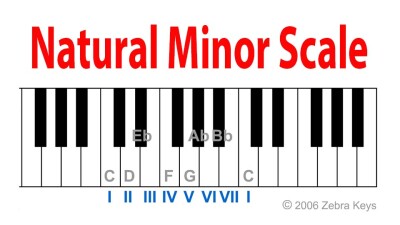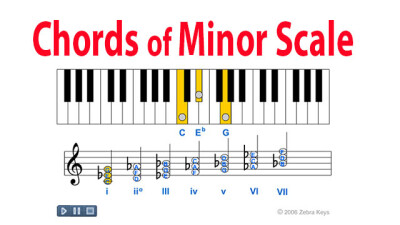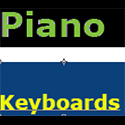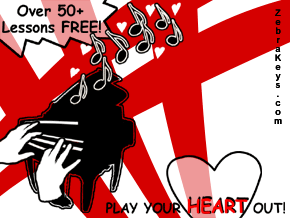Recommended
Categories
Music Theory
Lesson 33 - Chords of the Natural Minor Scale |
|---|
I. Index1. Introduction II. Content1. IntroductionIn this lesson, you will be looking at the chords built on the natural minor scale. Chords built on the natural minor scale can be named by its position in the natural minor scale using the Roman numerals I through VII (one through seven). This is useful when talking about the chords of the natural minor scale in general, and not chords of a specific natural minor scale.2. Chords Built on the Natural Minor ScaleLet's take a look at chords built on the natural minor scale, specifically the C natural minor scale. As seen in the animation below, the chord built on the first note of the C natural minor scale is identified by the Roman numeral i (one), the chord built on the second note is identified by the Roman numeral ii° (two), the chord built on the third note is identifed by the Roman numeral III (three), and so on.You will also notice that some of the Roman numerals are capitalized while others are not. This is sometimes used to identify the type of a chord. Uppercase Roman numerals mean a major chord. Lowercase Roman numerals mean a minor chord. Uppercase Roman numerals with a (+) symbol mean an augmented chord. Lowercase Roman numerals with a (o) symbol mean a diminished chord. In the natural minor scale, only the major chord, minor chord, and diminished chord occur naturally. The augmented chord does not occur naturally in the natural minor scale. 3. ConclusionIn this lesson, you took a look at chords built on the natural minor scale. You also learned that chords built on the natural minor scale can be identified by the Roman numerals one through seven. The Roman numeral being capital, lowercase, or with the (+) and (o) symbols next to them are sometimes used to signify the type of chord.
Custom Search
|
Recommended Stuff
| Flash Plugin is no longer available. Watch Lessons: 32 and 33 from the videos below: |
Lesson 32 |
Lesson 33 |
| C min | | | D min | | | E min | | | F min |
| G min | | | A min | | | B min | | | F# min |
| Ab min | | | Bb min | | | Db min | | | Eb min |
Intervals for Minor Scales are:
Root, WS, HS, WS, WS, HS, WS
Formula of Minor Scale is:
1, 2, b3, 4, 5, b6, b7
Notes for A Minor Scale are:
A, B, C, D, E, F, G, A
Learn Music Intervals
Notes for B Minor Scale are:
B, C#, D, E, F#, G, A, B
Notes for C Minor Scale are:
C, D, Eb, F, G, Ab, Bb, C
Notes for D Minor Scale are:
D, E, F, G, A, Bb, C
Notes for E Minor Scale are:
E, F#, G, A, B, C, D, and E
Notes for F Minor Scale are:
F, G, Ab, Bb, C, Db, Eb, F
Notes for G Minor Scale are:
G, A, Bb, C, D, Eb, F
Root, WS, HS, WS, WS, HS, WS
Formula of Minor Scale is:
1, 2, b3, 4, 5, b6, b7
Notes for A Minor Scale are:
A, B, C, D, E, F, G, A
Learn Music Intervals
Notes for B Minor Scale are:
B, C#, D, E, F#, G, A, B
Notes for C Minor Scale are:
C, D, Eb, F, G, Ab, Bb, C
Notes for D Minor Scale are:
D, E, F, G, A, Bb, C
Notes for E Minor Scale are:
E, F#, G, A, B, C, D, and E
Notes for F Minor Scale are:
F, G, Ab, Bb, C, Db, Eb, F
Notes for G Minor Scale are:
G, A, Bb, C, D, Eb, F






